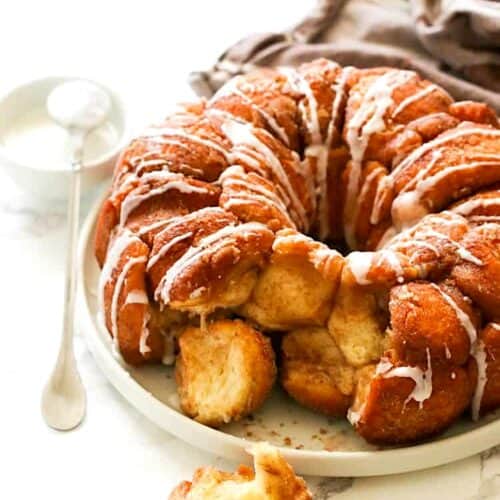Monkey Bread
A decadent pull-apart sweet bread generously rolled in cinnamon sugar, baked in a Bundt pan, and topped with a vanilla glaze. A soft, sweet, and sticky treat for a fun family gathering.
Servings 12
Calories 413kcal
Ingredients
The Bread
- 2 tablespoons (30ml) lukewarm water
- 1 package (2¼ teaspoons or 7g) active dry yeast
- 1 cup (237ml) warm milk (105-115℉/40-45℃)
- 5 tablespoons (70g) butter, cut into pieces
- ¼ cup (50g) granulated sugar
- 1 teaspoon (6g) salt
- 1 large egg
- 3½-3¾ cup (420-450g) flour
Cinnamon Sugar
- 1 cup (200g) light brown sugar
- 1 tablespoon (8-9g) ground cinnamon
- ½ cup (113g) unsalted butter, melted
The Glaze
- 1¾ cup (210g) confectioners' sugar
- 3 tablespoons (45g) heavy cream or milk to adjust to the desired thickness
- ½ teaspoon (3ml) vanilla extract
Instructions
- Combine the water and yeast in the bowl of a stand mixer with the dough hook. A large mixing bowl works fine if kneading by hand. Let it sit until dissolved for about 5 minutes.
- Meanwhile, in a medium microwave-safe bowl, combine the milk, butter pieces, sugar, and salt and microwave for about a minute. Stir until everything melts. Let it cool to lukewarm (105-115℉/40-45℃), so it doesn't kill the yeast.
- Pour the butter mixture into the yeast mixture and stir until well combined. Whisk in the egg.
- Gradually add 3½ cups of flour and continue mixing the dough.
- If mixing by hand, place the dough on a lightly floured surface and knead for 6-8 minutes.
- Add in enough additional flour (if needed) to make a soft dough. Err on the side of caution with less flour rather than more.
- Place the dough in a greased bowl, and turn once to coat it in the oil. Cover with a clean cloth loosely and let it rise in a warm, draft-free area for 1½ to 2 hours, or until doubled in size. Then, punch the dough down.
- Prepare the Bundt or tube pan by spraying it thoroughly with baking spray or greasing it with softened butter. Set aside.
- Combine the brown sugar and cinnamon in a small bowl for rolling the dough balls. Set aside.
- Remove the dough from the bowl and place it on a board.
- Roll the dough out into a rough square. Then, cut the dough into 45-50 pieces with a sharp knife. Roll all of the pieces of dough into balls.
- Next, dip the balls in melted butter and roll them in the cinnamon sugar until completely covered. Place the balls in the prepared Bundt pan, staggering them to randomly build layers.
- Cover the cake pan with plastic wrap or a clean kitchen cloth. Let it rise in a warm place for 30-45 minutes or until it has doubled in size. The duration depends on external influences, so keep a close eye on it and be patient.
- Preheat oven to 350℉ (180℃). Bake for 30-35 minutes or until golden brown on top. Remove from the oven and let cool for 5 minutes before carefully inverting it onto a plate.
The Glaze
- While the bread cools, make the optional glaze. Whisk the powdered sugar, milk, and vanilla in a small bowl until smooth. Drizzle the glaze over the warm monkey bread and serve.
Notes
- How long it takes the monkey bread to rise depends on the weather and humidity. It may take 30 minutes to an hour, so please be patient and keep an eye on it.
- Remove the monkey bread from the Bundt pan as soon as the 5 minutes are up, or it could stick to the bottom of the pan.
- If the top of the bread is getting too dark while baking, cover the top part loosely with tin foil.
- Make sure to grease the pan thoroughly (get all the little nooks) so you can get the bread out without tearing it up before digging in.
- If you're unsure whether the middle is cooked through, use an instant-read thermometer to check. As soon as it reads 190℉/88℃, it's done.
- I use traditional cinnamon in my recipe, but you can also use apple pie spices. I like to sneak a little ground cardamon in sometimes, too. Nuts and raisins would be a delicious addition.
- Please remember that the nutritional information is a rough estimate and can vary significantly depending on the products used in the recipe.
Nutrition
Serving: 100g | Calories: 413kcal | Carbohydrates: 68g | Protein: 3g | Fat: 15g | Saturated Fat: 10g | Polyunsaturated Fat: 1g | Monounsaturated Fat: 4g | Trans Fat: 1g | Cholesterol: 56mg | Sodium: 221mg | Potassium: 87mg | Fiber: 1g | Sugar: 59g | Vitamin A: 513IU | Vitamin C: 0.1mg | Calcium: 64mg | Iron: 1mg
